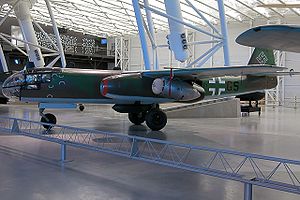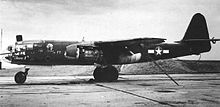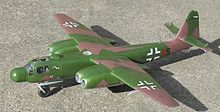Arado Ar 234 Video - Picture

|
|
Arado Ar 234

Aircraft Picture - Arado Ar 234 B-2 at the National Air and Space Museum's Steven F. Udvar-Hx¡zy Center
Role: Reconnaissance Bomber
Manufacturer: Arado Flugzeugwerke
Designer: Walter Blume
First flight: 15 June 1943
Introduction: September 1944
Status: Retired
Primary user: Luftwaffe
Number built: 210
The Arado Ar 234 was the world's first operational jet-powered bomber, built by the German Arado company in the closing stages of World War II. Produced in very limited numbers, it was used almost entirely in the reconnaissance role, but in its few uses as a bomber it proved to be nearly impossible to intercept. It was the last Luftwaffe aircraft to fly over England during the war, in April 1945.
The Ar 234 was commonly known as Blitz ("lightning"), although this name refers only to the B-2 bomber variant, and it is not clear whether it derived from the informal term Blitz-Bomber (roughly, "very fast bomber") or was ever formally applied. The alternate name Hecht ("pike") is derived from one of the units equipped with this aircraft, Sonderkommando Hecht.
Design and development
Background
In the autumn of 1940, the RLM offered a tender for a jet-powered high-speed reconnaissance aircraft with a range of 2,156 km (1,340 mi). Arado was the only company to respond, offering their E.370 project, led by Professor Walter Blume. This was a high-wing conventional-looking design with a Junkers Jumo 004 engine under each wing.
The projected weight for the aircraft was approximately 8,000 kg (17,600 lb). In order to reduce the weight of the aircraft and maximize the internal fuel, Arado did not use the typical retractable landing gear; instead, the aircraft was to take off from a jettisonable three-wheeled, nosegear-style trolley and land on three retractable skids, one under the central section of the fuselage, and one under each engine nacelle.
Arado estimated a maximum speed of 780 km/h (490 mph) at 6,000 m (19,690 ft), an operating altitude of 11,000 m (36,100 ft) and a range of 1,995 km (1,240 mi). The range was short of the RLM request, but they liked the design and ordered two prototypes as the Ar 234. These were largely complete before the end of 1941, but the Jumo 004 engines were not ready, and would not be ready until February 1943. When they did arrive they were considered unreliable by Junkers for in-flight use and were only cleared for static and taxi tests. Flight-qualified engines were finally delivered that spring, and the Ar 234 V1 made its first flight on 15 June 1943 at Rheine Airfield.
Variants
Prototypes
By September, four prototypes were flying. The second prototype, Arado Ar 234 V2, crashed 2 October 1943 at Rheine near Mx¼nster after suffering a fire in its port wing, failure of both engines and various instrumentation failures, the aircraft diving into the ground from 4,000 feet (1,200 m), killing pilot Flugkapitx¤n Selle. The eight prototype aircraft were fitted with the original arrangement of trolley-and-skid landing gear, intended for the planned operational, but never-produced Ar 234A version.
The sixth and eighth of the series were powered with four BMW 003 jet engines instead of two Jumo 004s, the sixth having four engines housed in individual nacelles, and the eighth flown with two pairs of BMW 003s installed within "twinned" nacelles underneath either wing. These were the first four-engine jet aircraft to fly. The Ar 234 V7 prototype made history on 2 August 1944 as the first jet aircraft ever to fly a reconnaissance mission.
Ar 234B

Airplane Picture - Ar 234 B with US markings.
The RLM had already seen the promise of the design and in July had asked Arado to supply two prototypes of a Schnellbomber ("fast bomber") version as the Ar 234B. Since the aircraft was very slender and entirely filled with fuel tanks, there was no room for an internal bomb bay and the bombload had to be carried on external racks. The added weight and drag of a full bombload reduced the speed, so two 20 mm fixed-mount, rearwards aimed MG 151 cannons were added in a remotely controlled tail position to give some measure of defence.
Since the cockpit was directly in front of the fuselage, the pilot had no direct view to the rear, so the guns were aimed through a periscope, derived from the type used on German World War II tanks, mounted on the cockpit roof. The system was generally considered useless, and many pilots had the guns removed to save weight. The external bombload, and the presence of inactive aircraft littering the landing field after their missions were completed (as with the similarly dolly/skid-geared Messerschmitt Me 163) made the skid-landing system impractical, so the B version was modified to have tricycle landing gear. The ninth prototype, marked with the Stammkennzeichen (radio code letters) PH+SQ, was the first Ar 234B, and flew on 10 March 1944.
The B models were slightly wider at the mid-fuselage to house the main landing gear, with a fuel tank present in the mid-fuselage location on the eight earlier trolley/skid equipped prototype aircraft having to be deleted for the retracted main gear's accommodation, and with full bombload, the aircraft could only reach 668 km/h (415 mph) at altitude. This was still better than any bomber the Luftwaffe had at the time, and made it the only bomber with any hope of surviving the massive Allied air forces. The normal bombload consisted of two 500 kg (1,100 lb) bombs suspended from the engines or one large 1,000 kg (2,200 lb) bomb semi-recessed in the underside of the fuselage with maximum bombload being 1,500 kg (3,310 lb). If the war had continued it is possible that the aircraft would have been converted to use the Fritz X guided bombs or Henschel Hs 293 air-to-surface missiles.
Production lines were already being set up, and 20 B-0 pre-production aircraft were delivered by the end of June. Later production was slow, however, as the Arado plants were given the task of producing planes from other bombed-out factories hit during the Big Week, and the ongoing license-building and nascent phasing-out of Heinkel's heavy He 177 bomber. Meanwhile, several of the prototypes were sent forward in the reconnaissance role. In most cases, it appears they were never even detected, cruising at about 740 km/h (460 mph) at over 9,100 m (29,900 ft), with the seventh prototype achieving the first-ever wartime reconnaissance mission over the United Kingdom by a Luftwaffe-used jet aircraft.
The few 234Bs entered service in the fall and impressed their pilots. They were fairly fast and completely aerobatic. The long takeoff runs led to several accidents; a search for a solution led to improved training as well as the use of rocket-assisted takeoff. The engines were always the real problem; they suffered constant flameouts and required overhaul or replacement after about 10 hours of operation.
The most notable use of the Ar 234 in the bomber role was the attempt to destroy the Ludendorff Bridge at Remagen. Between 7 March, when it was captured by the Allies, and 17 March, when it finally collapsed, the bridge was continually attacked by Ar 234s of III/KG 76 carrying 1,000 kg (2,200 lb) bombs. The aircraft continued to fight in a scattered fashion until Germany surrendered on 8 May 1945. Some were shot down in air combat, destroyed by flak, or "bounced" by Allied fighters during takeoff or on the landing approach, as was already happening to Messerschmitt Me 262 jet fighters. Most simply sat on the airfields awaiting fuel that never arrived.
Overall from the summer of 1944 until the end of the war a total of 210 aircraft were built. In February 1945, production was switched to the C variant. It was hoped that by November 1945 production would reach 500 per month.
Ar 234B-0 : 20 pre-production aircraft.
Ar 234B-1 : Reconnaissance version, equipped with two Rb 50/30 or Rb 75/30 cameras.
Ar 234B-2 : Bomber version, with a maximum bombload of 2,000 kg (4,410 lb).
In addition, a handful of B-2 airframes were adapted for the night-fighting role. These so-called Nachtigall (Nightingale) aircraft were fitted with FuG 218 "Neptun" VHF-band radar and carried a pair of forward-firing MG 151/20 autocannon within a Magirusbombe conformal gun pod on the ventral fuselage hardpoint. A second crewmember, who operated the radar systems, was accommodated in a very cramped compartment in the rear fuselage. Two of these jury-rigged night fighters served with Kommando Bonow, an experimental test unit attached to Luftflotte Reich. Operations commenced with the pair of 234s in March 1945, but Bonow's team soon found the aircraft to be unsuited for night fighting and no kills were recorded during the unit's very brief life.
Ar 234C
The Ar 234C was equipped with four BMW 003A engines, mounted in a pair of twin-engine nacelles based on those from the eighth Ar 234 prototype. The primary reason for this switch was to free up Junkers Jumo 004s for use by the Me 262, but the change improved overall thrust, especially in takeoff and climb-to-altitude performance. An improved cockpit design, with a slightly bulged outline for the upper contour, also used a much-simplified window design for ease of production. Airspeed was found to be about 20% higher than the B series and the faster climb to altitude meant more efficient flight and increased range.
Although Hauptmann Diether Lukesch was preparing to form an operational test squadron, only 14 C-series airframes had been completed by war's end, and of that number fewer than half had been fitted with engines. Comprehensive flight testing of the new sub-type had yet to begin when Germany surrendered. Three basic variants of the C-series were planned for initial construction, with several more laid out as detailed proposals. Some of these would have had different powerplants, while others were intended to feature swept or "crescent"-type wings.
Ar 234C-1 : Four-engined version of the Ar 234B-1.
Ar 234C-2 : Four-engined version of the Ar 234B-2.
Ar 234C-3 : Multi-purpose version, armed with two 20 mm MG 151/20 cannons beneath the nose.
Ar 234C-3/N : Proposed two-seat night fighter version, armed with two forward-firing 20 mm MG 151/20 and two 30 mm (1.18 in) MK 108 cannons, fitted with a FuG 218 Neptun V radar.
Ar 234C-4 : Armed reconnaissance version, fitted with two cameras, armed with four 20 mm MG 151/20 cannons.
Ar 234C-5 : Proposed version with side-by-side seating for the crew. The 28th prototype was converted into this variant.
Ar 234C-6 : Proposed two-seat reconnaissance aircraft. The 29th prototype was converted into this variant.
Ar 234C-7 : Night fighter version, with side-by-side seating for the crew, fitted with an enhanced FuG 245 Bremen O cavity magnetron-based centimetric (30 GHz) radar.
Ar 234C-8 : Proposed single-seat bomber version, powered by two 1,080 kg (2,380 lb) Jumo 004D turbojet engines.
Ar 234D
The D model was a two-seat aircraft based on the B-series fuselage, but with a new, enlarged two-seat cockpit, intended to be powered by a pair of more powerful Heinkel HeS 011 turbojet engines. The HeS 011 powerplant never reached quantity production, and no 234D was produced.
Ar 234D-1 : Proposed reconnaissance version. Not built.
Ar 234D-2 : Proposed bomber version. Not built.
Ar 234E
The E model was a heavy fighter variant of the D model. It was not produced.
Ar 234P

Airplane Picture - Model of Ar 234 P
The P model was a two-seat night fighter version, differing in powerplant options and several options of radar. Several were in the planning stage, but none made it into production.
Ar 234P-1 : Two seater with four BMW 003A-1 engines; one 20 mm MG 151/20 and one 30 mm (1.18 in) MK 108.
Ar 234P-2 : Also a two seater, with redesigned cockpit protected by a 13 mm (0.51 in) armour plate.
Ar 234P-3 : HeS 011A powered P-2, but with two each of the cannon.
Ar 234P-4 : as P-3 but with Jumo 004D engines.
Ar 234P-5 : Three seat version with HeS 011A engines, one 20 mm MG 151/20 and four 30 mm (1.18 in) MK 108s.
Operators
Germany
Luftwaffe
Kampfgeschwader 76 (Bomber unit)
1.(F)/100 (Reconnaissance unit)
1.(F)/123 (Reconnaissance unit)
1.(F)/33 (Reconnaissance unit)
Survivors
Only one Ar 234 survives today. The aircraft is an Ar 234B-2 bomber variant carrying Werknummer (manufacturer's serial number) 140312, and was one of nine Ar 234s surrendered to British forces at Sola Airfield near Stavanger, Norway. The aircraft had been operating with 9. Staffel III./Kampfgeschwader 76 (later reorganised as Einsatzstaffel) during the final weeks of the war, having operated previously with the 8th squadron.
This aircraft and three others were collected by the famous "Watson's Whizzers" of the USAAF to be shipped back to the United States for flight testing. Two aircraft were given freely but a further two had been traded to Watson by Eric "Winkle" Brown (test pilot and CO of the Enemy Aircraft Flight at the RAE) in exchange for an interview with Hermann Gx¶ring who was then being held by the Americans.
The aircraft was flown from Sola to Cherbourg, France on 24 June 1945 where it joined 34 other advanced German aircraft shipped back to the U.S. aboard the British aircraft carrier HMS Reaper. Reaper departed from Cherbourg on 20 July, arriving at Newark, New Jersey eight days later. Upon arrival two of the Ar 234s were reassembled (including 140312) and flown by USAAF pilots to Freeman Field, Indiana for testing and evaluation. 140312 was assigned the foreign equipment number FE-1010. The fate of the second Ar 234 flown to Freeman Field remains a mystery. One of the remaining two was reassembled by the United States Navy at Naval Air Station Patuxent River, Maryland, for testing, but was found to be in unflyable condition and was scrapped.
After receiving new engines, radio and oxygen equipment, 140312 was transferred to Wright Field near Dayton, Ohio and delivered to the Accelerated Service Test Maintenance Squadron (ASTMS) of the Flight Test Division in July 1946. Flight testing was completed on 16 October 1946 though the aircraft remained at Wright Field until 1947. It was then transferred to Orchard Place Airport, Park Ridge, Illinois, and remained at Orchard Place Airport until 1 May 1949 when it, and several other aircraft stored at the airport were transferred to the Smithsonian Institution. During the early 1950s the Ar 234 was moved to the Smithsonian's Paul Garber Restoration Facility at Suitland, Maryland for storage and eventual restoration.
The Smithsonian began restoration of 140312 in 1984 and completed it in February 1989. All paint had been stripped from the aircraft before the Smithsonian received it, so the aircraft was painted with the markings of an aircraft of 8./KG 76, the first operational unit to fly the "Blitz". The restored aircraft was first displayed at the Smithsonian's main museum building in downtown Washington D.C. in 1993 as part of a display titled "Wonder Weapon? The Arado Ar 234". In 2005 it became one of the first aircraft moved to the new Steven F. Udvar-Hazy Center near Dulles International Airport. Today, 140312 is displayed next to the last surviving Dornier Do 335, an aircraft that had accompanied it on its voyage across the Atlantic Ocean aboard the Reaper over 60 years earlier.
This aircraft is displayed with a pair of Hellmuth Walter designed, liquid-fueled RATO units mounted under its wings. These RATO units may be the only surviving examples to be mounted on an aircraft.
Specifications (Ar 234B)
General characteristics
Crew: 1
Length: 12.63 m (41 ft 5½ in)
Wingspan: 14.10 m (46 ft 3½ in)
Height: 4.30 m (14 ft 1¼ in)
Wing area: 26.40 m² (284.16 ft²)
Empty weight: 5,200 kg (11,460 lb)
Max takeoff weight: 9,850 kg (21,720 lb)
Powerplant: 2 x— Junkers Jumo 004B-1 turbojets, 8.80 kN (1,980 lbf) each
Performance
Maximum speed: 742 km/h (461 mph) at 6,000 m (19,700 ft)
Combat radius: 1,100 km (684 mi) with maximum bombload
Service ceiling: 10,000 m (32,800 ft)
Rate of climb: 10-13 m/s ()
Armament
Guns: 2 x— 20 mm MG 151 cannon in tail firing to the rear (optional)
Bombs: up to 1,500 kg (3,309 lb) of disposable stores on external racks (1,800 kg when overloaded)
Comparable aircraft
Junkers Ju 287
Bibliography
Bateson, Richard P. Arado Ar 234 Blitz (Aircraft in Profile 215). Windsor, Berkshire, UK: Profile Publications Ltd., 1972.
Boyne, Walter J. Clash of Wings. New York: Simon & Schuster, 1994. ISBN 0-684-83915-6.
Brown, Eric. Wings On My Sleeve: The World's Greatest Test Pilot Tells his Story. London: Orion Books, 2006, ISBN 0-297-84565-9.
Ethell, Jeffrey L. Aerei della II guerra mondiale (in Italian). Milan: A. Vallardi, 1996. ISBN 88-11-94026-5
Fleischer, Seweryn and Marek Ryś. Ar 234 Blitz (Aircraft Monograph 10). Gdańsk, Poland: AJ-Press, 2nd expanded edition, 2004. ISBN 83-7237-146-2.
Griehl, Manfred. Arado Ar 234 (Luftwaffe Profile Series no. 15). Atglen, Pennsylvania: Schiffer Books, 2001. ISBN 0-7643-1431-9.
Griehl, Manfred. Strahlflugzeug Arado Ar 234 'Blitz' (in German). Stuttgart, Germany: Motorbuch Verlag, 2003. ISBN 3-61302-287-7.
Kobel, Franz. The World's First Jet Bomber: Arado Ar 234. Atglen, Pennsylvania: Schiffer Books, 1991. ISBN 0-88740-203-8.
Kranzhoff, Jx¶rg Armin. Arado, History of an Aircraft Company. Atglen, Pennsylvania: Schiffer Books, 1997. ISBN 0-7643-0293-0.
Murawski, Marek J. Arado Ar 234 Blitz (Kagero Monograph 33) (bilingual Polish/English). Lublin, Poland: Kagero, 2007. ISBN 83-6044-566-2.
Myhra, David. Arado Ar 234C: An Illustrated History. Atglen, Pennsylvania: Schiffer Books, 2000. ISBN 0-7643-1182-4.
Price, Dr. Alfred. "Arado Ar 234". International Air Power Review, Volume 24, 2008. Westport, Connecticut: AIRTime Publishing Inc. ISSN 1473-9917.
Smith, J. Richard and Eddie J. Creek. Arado Ar 234 Blitz (Monogram Monarch Series No. 1). Boylston, Massachusetts: Monogram Aviation Publications, 1992. ISBN 0-91414-451-0.
Smith, J. Richard and Eddie J. Creek. Arado Ar 234B (Monogram Close-Up 23). Boylston, Massachusetts: Monogram Aviation Publications, 1984. ISBN 0-914144-23-5.
Smith, J. Richard and Eddie J. Creek. Military Aircraft in Detail: Arado Ar 234A. Hinckley, Leicestershire, UK: Midland, 2006. ISBN 1-85780-225-X.
Arado Ar 234 Pictures
More airplane video.
Source: WikiPedia